本篇内容介绍了“在使用Spring Security OAuth3时如何自定义认证服务器返回异常”的有关知识,在实际案例的操作过程中,不少人都会遇到这样的困境,接下来就让小编带领大家学习一下如何处理这些情况吧!希望大家仔细阅读,能够学有所成!
那么首先我们先以 Password模式为例看看在认证时会出现哪些异常情况。
授权模式错误
这里我们故意将授权模式 password 修改成 password1,认证服务器返回如下所示的异常
{
"error": "unsupported_grant_type",
"error_description": "Unsupported grant type: password1"
}
密码错误
在认证时故意输错 username 或 password 会出现如下异常错误:
{
"error": "invalid_grant",
"error_description": "Bad credentials"
}
客户端错误
在认证时故意输错 client_id 或 client_secret
{
"error": "invalid_client",
"error_description": "Bad client credentials"
}
上面的返回结果很不友好,而且前端代码也很难判断是什么错误,所以我们需要对返回的错误进行统一的异常处理,让其返回统一的异常格式。
如果只关注解决方案,可以直接跳转到解决方案模块!
在Oauth3认证服务器中认证逻辑最终调用的是 TokenEndpoint#postAccessToken()方法,而一旦认证出现 OAuth3Exception异常则会被 handleException()捕获到异常。如下图展示的是当出现用户密码异常时debug截图:

认证服务器在捕获到 OAuth3Exception后会调用 WebResponseExceptionTranslator#translate()方法对异常进行翻译处理。
默认的翻译处理实现类是 DefaultWebResponseExceptionTranslator,处理完成后会调用 handleOAuth3Exception()方法将处理后的异常返回给前端,这就是我们之前看到的异常效果。
熟悉Oauth3套路的同学应该知道了如何处理此类异常,就是「自定义一个异常翻译类让其返回我们需要的自定义格式,然后将其注入到认证服务器中。」
但是这种处理逻辑只能解决 OAuth3Exception异常,即前言部分中的「授权模式异常」和「账号密码类的异常」,并不能解决我们客户端的异常。
客户端认证的异常是发生在过滤器 ClientCredentialsTokenEndpointFilter上,其中有后置添加失败处理方法,最后把异常交给 OAuth3AuthenticationEntryPoint这个所谓认证入口处理。执行顺序如下所示: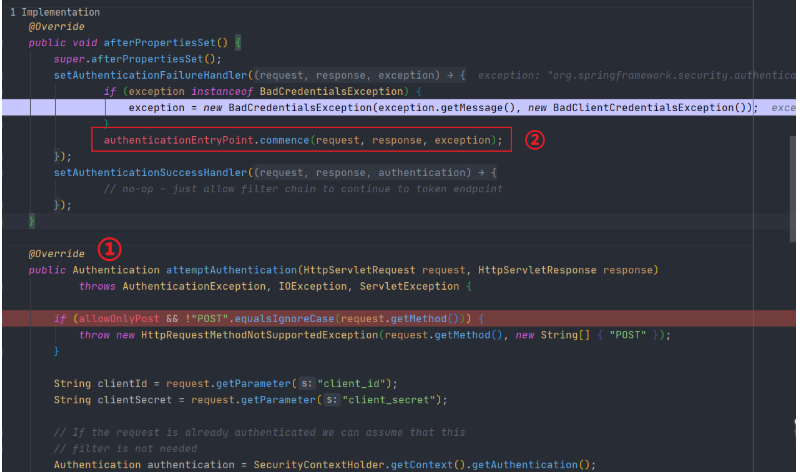
然后跳转到父类的 AbstractOAuth3SecurityExceptionHandler#doHandle()进行处理: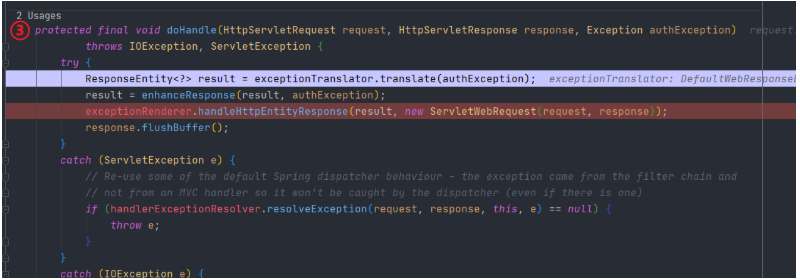
最终由 DefaultOAuth3ExceptionRenderer#handleHttpEntityResponse()方法将异常输出给客户端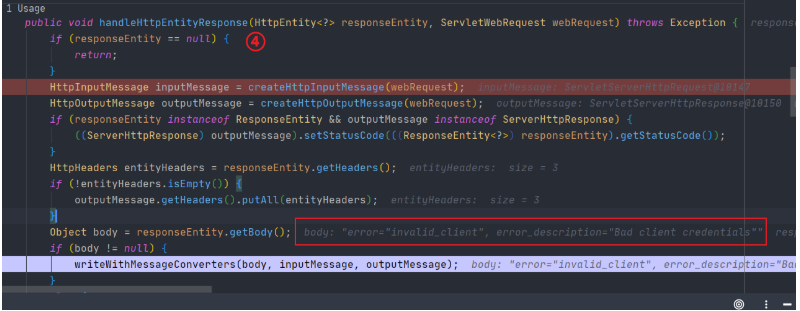
通过上面的分析我们得知客户端的认证失败异常是过滤器 ClientCredentialsTokenEndpointFilter转交给 OAuth3AuthenticationEntryPoint得到响应结果的,既然这样我们就可以重写 ClientCredentialsTokenEndpointFilter然后使用自定义的 AuthenticationEntryPoint替换原生的 OAuth3AuthenticationEntryPoint,在自定义 AuthenticationEntryPoint处理得到我们想要的异常数据。
为了解决上面这些异常,我们首先需要编写不同异常的错误代码:ReturnCode.java
CLIENT_AUTHENTICATION_FAILED(1001,"客户端认证失败"),
USERNAME_OR_PASSWORD_ERROR(1002,"用户名或密码错误"),
UNSUPPORTED_GRANT_TYPE(1003, "不支持的认证模式");
如上所说我们编写一个自定义异常翻译类 CustomWebResponseExceptionTranslator
@Slf4j
public class CustomWebResponseExceptionTranslator implements WebResponseExceptionTranslator {
@Override
public ResponseEntity<ResultData<String>> translate(Exception e) throws Exception {
log.error("认证服务器异常",e);
ResultData<String> response = resolveException(e);
return new ResponseEntity<>(response, HttpStatus.valueOf(response.getHttpStatus()));
}
/**
* 构建返回异常
* @param e exception
* @return
*/
private ResultData<String> resolveException(Exception e) {
// 初始值 500
ReturnCode returnCode = ReturnCode.RC500;
int httpStatus = HttpStatus.UNAUTHORIZED.value();
//不支持的认证方式
if(e instanceof UnsupportedGrantTypeException){
returnCode = ReturnCode.UNSUPPORTED_GRANT_TYPE;
//用户名或密码异常
}else if(e instanceof InvalidGrantException){
returnCode = ReturnCode.USERNAME_OR_PASSWORD_ERROR;
}
ResultData<String> failResponse = ResultData.fail(returnCode.getCode(), returnCode.getMessage());
failResponse.setHttpStatus(httpStatus);
return failResponse;
}
}
然后在认证服务器配置类中注入自定义异常翻译类
@Override
public void configure(AuthorizationServerEndpointsConfigurer endpoints) throws Exception {
//如果需要使用refresh_token模式则需要注入userDetailService
endpoints
.authenticationManager(this.authenticationManager)
.userDetailsService(userDetailService)
// 注入tokenGranter
.tokenGranter(tokenGranter);
//注入自定义的tokenservice,如果不使用自定义的tokenService那么就需要将tokenServce里的配置移到这里
// .tokenServices(tokenServices());
// 自定义异常转换类
endpoints.exceptionTranslator(new CustomWebResponseExceptionTranslator());
}
重写客户端认证过滤器,不使用默认的 OAuth3AuthenticationEntryPoint处理异常
public class CustomClientCredentialsTokenEndpointFilter extends ClientCredentialsTokenEndpointFilter {
private final AuthorizationServerSecurityConfigurer configurer;
private AuthenticationEntryPoint authenticationEntryPoint;
public CustomClientCredentialsTokenEndpointFilter(AuthorizationServerSecurityConfigurer configurer) {
this.configurer = configurer;
}
@Override
public void setAuthenticationEntryPoint(AuthenticationEntryPoint authenticationEntryPoint) {
super.setAuthenticationEntryPoint(null);
this.authenticationEntryPoint = authenticationEntryPoint;
}
@Override
protected AuthenticationManager getAuthenticationManager() {
return configurer.and().getSharedObject(AuthenticationManager.class);
}
@Override
public void afterPropertiesSet() {
setAuthenticationFailureHandler((request, response, e) -> authenticationEntryPoint.commence(request, response, e));
setAuthenticationSuccessHandler((request, response, authentication) -> {
});
}
}
在认证服务器注入异常处理逻辑,自定义异常返回结果。(代码位于 AuthorizationServerConfig)
@Bean
public AuthenticationEntryPoint authenticationEntryPoint() {
return (request, response, e) -> {
response.setStatus(HttpStatus.UNAUTHORIZED.value());
ResultData<String> resultData = ResultData.fail(ReturnCode.CLIENT_AUTHENTICATION_FAILED.getCode(), ReturnCode.CLIENT_AUTHENTICATION_FAILED.getMessage());
WebUtils.writeJson(response,resultData);
};
}
修改认证服务器配置,注入自定义过滤器
@Override
public void configure(AuthorizationServerSecurityConfigurer security) throws Exception {
CustomClientCredentialsTokenEndpointFilter endpointFilter = new CustomClientCredentialsTokenEndpointFilter(security);
endpointFilter.afterPropertiesSet();
endpointFilter.setAuthenticationEntryPoint(authenticationEntryPoint());
security.addTokenEndpointAuthenticationFilter(endpointFilter);
security
.authenticationEntryPoint(authenticationEntryPoint())
/* .allowFormAuthenticationForClients()*/ //如果使用表单认证则需要加上
.tokenKeyAccess("permitAll()")
.checkTokenAccess("isAuthenticated()");
}
此时需要删除 allowFormAuthenticationForClients()配置,否则自定义的过滤器不生效,至于为什么不生效大家看看源码就知道了。
授权模式错误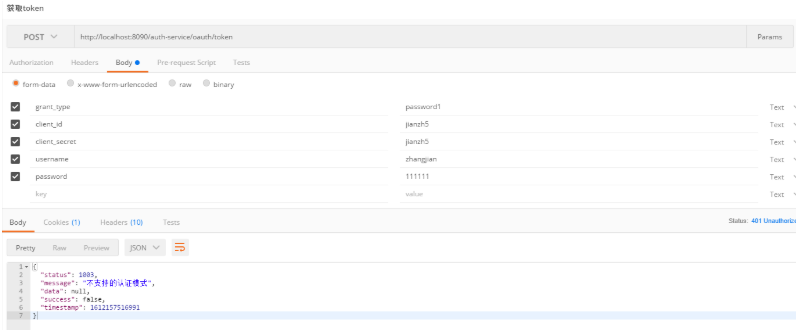
账号密码错误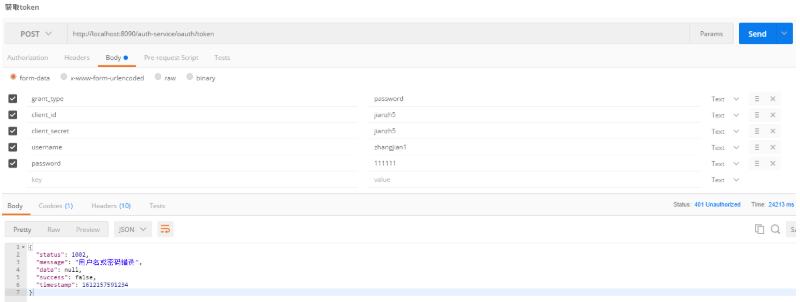
客户端错误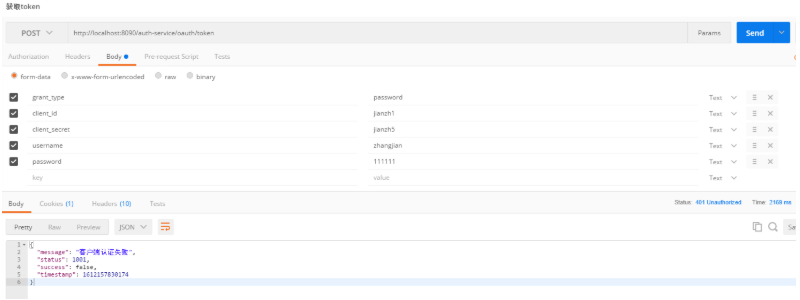
“在使用Spring Security OAuth3时如何自定义认证服务器返回异常”的内容就介绍到这里了,感谢大家的阅读。如果想了解更多行业相关的知识可以关注亿速云网站,小编将为大家输出更多高质量的实用文章!
免责声明:本站发布的内容(图片、视频和文字)以原创、转载和分享为主,文章观点不代表本网站立场,如果涉及侵权请联系站长邮箱:is@yisu.com进行举报,并提供相关证据,一经查实,将立刻删除涉嫌侵权内容。